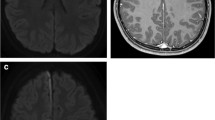Abstract
Supplementary motor area, the posterior third of the medial aspect of superior frontal gyrus, is known to be a heterogeneous area in function. It is involved in self-initiated motor movements, planning and sequencing the motor action, response inhibition, and bimanual movements. Blood supply for supplementary motor area is mostly by callosomarginal branch of anterior cerebral artery. Stroke in anterior cerebral artery territory is relatively uncommon, moreover, isolated supplementary motor area stroke is a rare entity. Supplementary motor area stroke, as a syndrome, has variable symptoms consisting of impairment of volitional movements, hemineglect, dyspraxia of contralateral limbs, impaired muscle tone, mutism and contralateral weakness. As symptoms are sometimes ambivalent, patients may be misdiagnosed as functional disorder and lose the chance for immediate adequate treatments such as thrombolysis. We report a 59-year-old man with previous history for myocardial infarction, referred to emergency room with an acute dense right-side hemiplegia, positive Hoover sign, asymmetrical Babinski responses and intermittent ability to move his arm in some specific reflex actions despite plegia. Since brain computed tomography scan was unremarkable we could not be sure whether his symptoms were organic or functional until a diffusion weighted imaging of magnetic resonance imaging elucidated the situation. To our knowledge, there is only one case report in the literature prior to ours, presenting a supplementary motor area stroke patient, mimicking functional disorder. Therefore, we may claim our report to be the second reported case.

Similar content being viewed by others
References
Nachev P, Kennard C, Husain M (2008) Functional role of the supplementary and pre-supplementary motor areas. Nat Rev Neurosci 9:856
Brugger F, Galovic M, Weder BJ, Kägi G (2015) Supplementary motor complex and disturbed motor control—a retrospective clinical and lesion analysis of patients after anterior cerebral artery stroke. Front Neurol 6:209
Mathew P, Batchala PP, Eluvathingal Muttikkal TJ (2018) Supplementary motor area stroke mimicking functional disorder. Stroke 49(2):e28–e30
Wongsripuemtet J, Tyan A, Carass A, Agarwal S, Gujar S, Pillai J et al (2018) Preoperative mapping of the supplementary motor area in patients with brain tumor using resting-state fMRI with seed-based analysis. Am J Neuroradiol 39(8):1493–1498
Chung GH, Han YM, Jeong SH, Jack CR (2005) Functional heterogeneity of the supplementary motor area. Am J Neuroradiol 26(7):1819–1823
Cona G, Semenza C (2017) Supplementary motor area as key structure for domain-general sequence processing: a unified account. Neurosci Biobehav Rev 72:28–42
Kang SY, Kim JS (2008) Anterior cerebral artery infarction: stroke mechanism and clinical-imaging study in 100 patients. Neurology 70(24 Part 2):2386–2393
Alonso A, Gass A, Rossmanith C, Kern R, Griebe M, Binder J et al (2012) Clinical and MRI patterns of pericallosal artery infarctions: the significance of supplementary motor area lesions. J Neurol 259(5):944–951
Voon V, Brezing C, Gallea C et al (2011) Aberrant supplementary motor complex and limbic activity during motor preparation in motor conversion disorder. Mov Disord 26:2396–2403
Pick S, Goldstein LH, Perez DL et al (2018) (2018) Emotional processing in functional neurological disorder: a review, biopsychosocial model and research agenda. J Neurol Neurosurg Psychiatry 90:704
Booij H, Hamburger H, Jöbsis G, Beuerle E, Kruyt N (2012) Stroke mimicking conversion disorder: two young women who put our feet back on the ground. Pract Neurol 12(3):179–181
Crimlisk HL, Bhatia K, Cope H, David A, Marsden CD, Ron MA (1998) Slater revisited: 6 year follow up study of patients with medically unexplained motor symptoms. BMJ 316(7131):582–586
McWhirter L, Stone J, Sandercock P et al (2011) Hoover's sign for the diagnosis of functional weakness: a prospective unblinded cohort study in patients with suspected stroke. J. Psychosom Res 71:384–386
Author information
Authors and Affiliations
Corresponding author
Ethics declarations
Conflicts of interest
On behalf of all authors, the corresponding author states that there is no conflict of interest.
Rights and permissions
About this article
Cite this article
Mohebi, N., Arab, M., Moghaddasi, M. et al. Stroke in supplementary motor area mimicking functional disorder: a case report. J Neurol 266, 2584–2586 (2019). https://doi.org/10.1007/s00415-019-09479-7
Received:
Revised:
Accepted:
Published:
Issue Date:
DOI: https://doi.org/10.1007/s00415-019-09479-7




